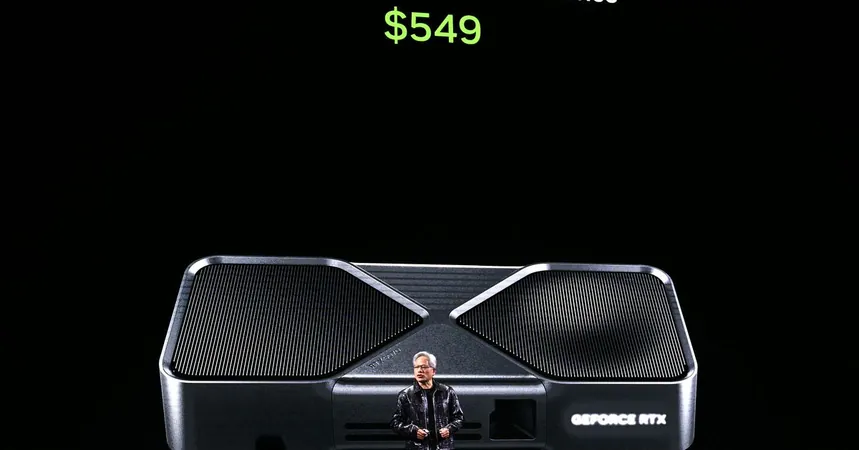
Can Nvidia's RTX 5070 Truly Rival RTX 4090 Performance for Just $549?
2025-01-08
Author: Ting
Introduction
Nvidia's CEO, Jensen Huang, stirred excitement at CES this week with a striking announcement regarding the highly anticipated RTX 5070 graphics card. He boldly claimed, “The RTX 5070 can deliver RTX 4090 performance at just $549.” This statement has sparked significant chatter across social media platforms, reigniting discussions around Nvidia’s RTX 50 series and its groundbreaking DLSS (Deep Learning Super Sampling) 4's Multi Frame Generation.
The Comparison: RTX 5070 vs. RTX 4090
But is the RTX 5070 truly capable of matching the extraordinary capabilities of the RTX 4090, which carries a hefty price of $1,599? The reality is nuanced, and hinges upon how we interpret what's being touted as “performance.” The discussion largely revolves around the concept of “fake frames” generated through DLSS's innovative techniques—an aspect that could be a dealbreaker for some seasoned PC gamers, while perhaps less impactful for the majority.
DLSS 4 and AI Integration
Central to Nvidia’s claim is their latest iteration of DLSS. Huang acknowledges the role of artificial intelligence in this performance leap, stating, “This is impossible without artificial intelligence.” The introduction of DLSS 4 enables the RTX 5070 to generate up to three additional frames for every frame rendered traditionally, a breakthrough that’s stirred considerable debate about the authenticity of gaming performance.
Skepticism Among Gamers
Many gamers have voiced skepticism, dubbing DLSS's additional frames as “fake frames.” This perception stems from the fact that traditional rendering has defined gaming for decades. Lars Weinand, Nvidia’s senior technical product manager, clarified the company's position by explaining that while the RTX 5070 may not outperform the RTX 4090 in every aspect, it can achieve frame rates that previously seemed exclusive to the flagship model when using DLSS 4.
Practical Performance in Gaming
In practical terms, this means the RTX 5070 will excel in titles optimized for DLSS 4, such as Cyberpunk 2077, where it could boost frame rates dramatically—from a mere 27fps to an astonishing 243fps when enabled. While these figures are impressive, they do raise questions about actual gameplay experience, especially regarding pure rasterization performance, which remains the realm of higher-end cards like the RTX 4090.
Critics and the Fake Frames Debate
Critics are quick to revisit the “fake frames” debate initiated with the unveiling of DLSS 3 Frame Generation. This tactic involves generating frames based on algorithms, allowing gamers to enjoy smoother visuals at higher frame rates. DLSS 4 not only pushes the envelope further by potentially delivering frame rates that are up to eight times higher than standard rendering but also does so with newer transformer models for increased efficiency, utilizing less VRAM.
Innovation in DLSS 4
One intriguing aspect discussed during CES was that DLSS 4 purportedly 'predicts the future' rather than merely interpolating previous frames. This innovation is designed to minimize latency, with Digital Foundry reporting minimal additional lag when using DLSS 4—increasing smoothness without noticeably detracting from the overall gaming experience.
Input Latency Considerations
However, input latency remains a critical factor, particularly in fast-paced games. Even if DLSS 4 can elevate frame rates to impressive levels, it may not eliminate the sluggish feeling sometimes associated with lower native frame outputs. This discrepancy can be noticeable, especially for gamers accustomed to high frame rates, leading to mixed opinions around the technology.
The Future of Gaming Graphics
The ongoing transformation of gaming, with a growing emphasis on ray tracing and advanced visual effects, comes with a realization—many gamers may find value in the resulting visual enhancements, even if they rely on “fake frames.” Nvidia’s push for AI-driven rendering techniques indicates a significant shift in how games will be crafted moving forward.
Industry-Wide Trends
This trend is echoed across the industry, with competitors like Sony and AMD also exploring similar enhancements, solidifying the notion that AI-based rendering is here to stay. While some may staunchly resist the idea of “fake frames,” it’s evident that graphics technologies are evolving at a breakneck pace, and adaptive solutions like DLSS 4 could unlock new horizons for gaming graphics and performance.
Conclusion
As Nvidia raises the bar, gamers are left at a crossroads—whether to embrace the exciting potential of AI-enhanced rendering or cling to the traditional definitions of performance. The future of gaming may be more adaptable and visually stunning than ever imagined, inviting players to experience even more immersive worlds. Buckle up, gamers—this is just the tip of the iceberg in graphics technology!


 Brasil (PT)
Brasil (PT)
 Canada (EN)
Canada (EN)
 Chile (ES)
Chile (ES)
 Česko (CS)
Česko (CS)
 대한민국 (KO)
대한민국 (KO)
 España (ES)
España (ES)
 France (FR)
France (FR)
 Hong Kong (EN)
Hong Kong (EN)
 Italia (IT)
Italia (IT)
 日本 (JA)
日本 (JA)
 Magyarország (HU)
Magyarország (HU)
 Norge (NO)
Norge (NO)
 Polska (PL)
Polska (PL)
 Schweiz (DE)
Schweiz (DE)
 Singapore (EN)
Singapore (EN)
 Sverige (SV)
Sverige (SV)
 Suomi (FI)
Suomi (FI)
 Türkiye (TR)
Türkiye (TR)
 الإمارات العربية المتحدة (AR)
الإمارات العربية المتحدة (AR)